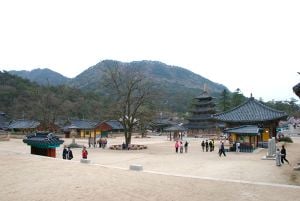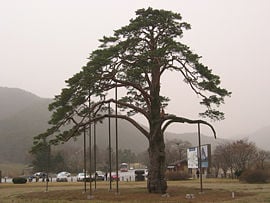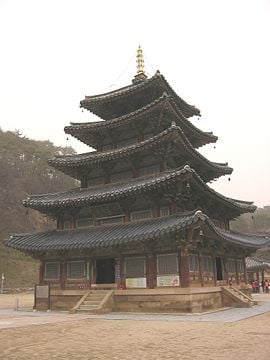Beopjusa
| Beopjusa | ||||||||
|---|---|---|---|---|---|---|---|---|
|
Beopjusa one of Korea's oldest and greatest Buddhist temples, founded in 553 C.E., has been active for more than 1400 years. The name of the temple means "Buddha stays here." Situated on the slopes of Songnisan ('renouncing the world') mountain (within Songnisan National Park), at times during its history Beopjusa has been home to more than 3,000 monks. Since the eighth century, the temple has been designated as central temple for worship and teaching of the Maitreya Buddha, the Buddha of the future who will return to save the world. In recent times, Beopjusa has become known for its 33-meter-tall gold statue of the Maitreya Buddha.
History of Beopjusa
Beopjusa founded in 553 C.E., in the Shilla Kingdom during the fourteenth year of King Jinheung's reign, just 24 years after Buddhism was first introduced to the Silla Kingdom, temple construction began under the leadership of the monk Uisinchosa. In 776, monks Jinpyo and Youngshim gained the patronage of King Hyegong, and the temple flourished. In the Goryeo dynasty, as many as 3,000 monks practiced and lived in Beopjusa. Some of the original structures from 653 still stand on the temple grounds, including a cistern and iron pot for serving food and water to thousands of monks. Beopjusa thrived as a center for the Jogye Order until the Joseon Dynasty. By the middle of the Joseon Dynasty, the complex contained more than 60 buldings and 70 hermitages, or individual meditation cottages.
However, almost of them burned to the ground during the Japanese invasion of 1592, but, as the Confucian Joseon court refused to support the Buddhist temples, more than 30 years passed before reconstruction began in 1624, under abbot Byeokam. In its history, Beopjusa has undergone reconstruction eight times, including a major nationwide reconstruction in 1851. None of the original buildings remain.
A Temple worshiping the Maitreya
From its early days, Beopjusa has been associated with Beopsang thought and the worship of the Maitreya Buddhaâthe Buddha who is to come. It is predicted that thousands, even millions of years after Sakyumini's death the Maitreya will come to earth from the spiritual realm where he currently resides. Living with mankind on the earth, he will deliver three important messages, the Three Yonghwa Sermons. Mankind will unite in worship of the Maitreya, live according to the teachings in the Three Yonghwa Sermons and commit acts of goodness, thus securing their salvation.
In the eighth century the Monk Jinpyo founded Geumsan Temple as a Seminary for teaching the Three Yonghwa Sermons, followed by followed by Beopjusa Temple as a second Seminary and Balyeonsa Temple on Mt. Geumgang as a 3rd Seminary, thus these three temples are known as the central teaching temples for the Three Yonghwa Sermons.
Legends regarding Beopjusa
Holy Relics. It is said that in the eleventh year King Gomin's reign, the king was inspired by the spirit of Beupjusa and sent an Imperial envoy to Tongdosa ordering that some of the holy relics be sent from Tongdosa to Beopjusa, and that are enshrined in a reliquary behind Sujongbong and Neunginjeon.
Legend states that Taejo, the founder of the Joseon Dynasty retired to a spot near Beopjusa frustrated by his sons' fighting for power.
It is also said that King Sejo of Joseon directed that renovations be made on the great temple Beopjusa on Songrisan Mountain, after he had a mystical experience with a pine tree near the entrance of of the Temple. Sejo, the second son of Sejong the Great gained the throne by murdering his nephew; later in life he was afflicted with a skin condition and went to the Songrisan Mountains to search for healing of his body and spirit. On the way to Beopjusa, he encountered two young boys who called him "Grandfather" who were traveling with his daughter, Princess Uisok, who had tried to prevent Sejo from killing his nephew, and then fled afterward, in fear for her life. King Sejo begged for her forgiveness, but she was still afraid, and rejected his invitation to return to the palace. However, the pine tree bowed its branches in front of Sejo in recognition of his repentance.
Palsongjeon Pagoda: National Treasure No. 55
Palsangjeon Pagoda (íìì æç¸æ®¿) Eight Paintings Pagoda, a large wooden pagoda, was originally built in 553 when the temple was founded. A copy of the pagoda was built in Nara, Japan, 50 years later, and is still standing. The Palsangjeon Hall currently at Beopjusa is a reconstruction dating from 1624 and has been preserved since that time, making it the oldest wooden pagoda in Korea. Palsangjeon Pagoda has been designated National Treasure No. 55.
The five-story pagoda has large murals describing Sakyumuni Buddha's life. A walk around the hall gives Buddhists the chance to remember the important events in Buddha's life. In addition to the paintings, there are fours statues of Sakyamuni, facing different directions, with different hand positionsâfearless in the Buddha facing east, the west Buddha is Turning the Wheel of Dharma, the south Buddha is touching the earth and the north Buddha is lying down in a dying pose, very rare in Korea.
The hall also features 500 small white statues of Buddha sometimes called disciples of Buddha, but they are really images of Buddha himself, made with the 32 aspects and 80 features of the Buddha, including curled hair, a bump on the head and long ears.
Facing down at the pagoda is a 33-meter-high, 160 ton copper statue of the Maitreya Buddha. An earlier statue, made by Chinpyo was taken by Daewongun in 1872, and melted down to make money to help finance the restoration of Kyungbokgung. Work was started on a replacement in 1939, which was finally completed in 1964 with a donation from President Park. The current bronze statue was constructed in 1990, which was later plated with gold. A rainbow mysteriously appeared in the sky when the new statue was dedicated.
Beopjusa Temple today
Beopjusa Temple in Naesongni-myeon, Boeun County, in the province of Chungcheongbuk-do, South Korea is is one of 25 district headquarter temples for the Jogye Order of Korean Buddhism, Korean's largest Buddhist sect, with 27 temples under its supervision. Currently, the Beopjusa Temple complex has about thirty buildings, and hosts a Songnichukjeon Festival every year in April of the Lunar calendar. The temple is home to four national treasures (one now has been moved to the National Museum of Korea, Seoul) and a number of local treasures.
Gallery
Iljumun Gate, the first entrance gate on the path to Beopjusa from the Songrisan Mountain National Park.
A large water basin in the shape of a half-opened magnolia flower, National Treasure No. 64.
- A special golden path covered with pebbles of baked yellow earth leads through the forest on Songrisan Mountain to the entrance of Beopjusa temple.
- Seokyeonji Lotus Flower Pond
- A picture of Buddha sitting on a lotus flower, carved in rock.
- Memorial Stupa for the Most Reverend Jigwang of Beopcheonsa temple, National Treasure #101, now housed in the National Museum of Korea, Seoul.
See also
- Korean Buddhist temples
- Korean Buddhism
- Religions in Korea
- Korean architecture
- List of Korea-related topics
ReferencesISBN links support NWE through referral fees
- Covell, Jon Etta Hastings Carter, and Alan Carter Covell. 1982. Korea's Buddhist temples. Seoul: Korea National Tourism Corp. OCLC: 49700821
- Gyun, Heo, and Timothy V. Atkinson. 2005. Korean temple motifs: beautiful symbols of the Buddhist faith. Gyeonggi-do, Korea: Dolbegae Publishers. ISBN 9788971992272
- Hanʼguk Kwanʼgwang Kongsa. 1996. Exploring Korean Buddhist temples. Seoul, Korea: Korea National Tourism Organization. OCLC: 53022956
- International Dharma Instructors Association. 1995. Guide to Korean Buddhist temples. Seoul, Korea: Jogye Order. ISBN 9788986821130
- Larkin, Geraldine A. 2001. First you shave your head. Berkeley, CA: Celestial Arts. ISBN 9781587610097
- Verebes, Chris. 2002. Empty house: zen masters and temples of Korea. Seoul, Korea: Eastward Publications. ISBN 9788995215548
Credits
New World Encyclopedia writers and editors rewrote and completed the Wikipedia article in accordance with New World Encyclopedia standards. This article abides by terms of the Creative Commons CC-by-sa 3.0 License (CC-by-sa), which may be used and disseminated with proper attribution. Credit is due under the terms of this license that can reference both the New World Encyclopedia contributors and the selfless volunteer contributors of the Wikimedia Foundation. To cite this article click here for a list of acceptable citing formats.The history of earlier contributions by wikipedians is accessible to researchers here:
The history of this article since it was imported to New World Encyclopedia:
Note: Some restrictions may apply to use of individual images which are separately licensed.






